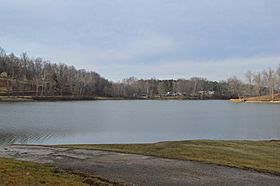Jackson Lake State Park (Ohio) facts for kids
Quick facts for kids Jackson Lake State Park |
|
|---|---|

Jackson Lake
|
|
| Lua error in Module:Location_map at line 420: attempt to index field 'wikibase' (a nil value). | |
| Location | Jackson County, Ohio, United States |
| Area | 106 acres (43 ha) |
| Elevation | 860 ft (260 m) |
| Established | 1979 |
| Administered by | Ohio Department of Natural Resources |
| Designation | Ohio state park |
| Website | Jackson Lake State Park |
Jackson Lake State Park is a fun place to visit in Jackson County, Ohio, United States. It covers about 106 acres (43 ha) right next to Jackson Lake. This park became a state park in 1979. Before that, it was a "state reserve" with fewer things to do. Long ago, trees from this area were used to fuel iron factories. Today, you can go camping, boating, fishing, swimming, and picnicking here.
Contents
Park History
Jackson Lake State Park is in eastern Ohio, north of the Ohio River. For a very long time, different groups of Native Americans lived in this area. You can still find signs of their presence. Large burial mounds and petroglyphs (rock carvings) are found nearby. The famous Leo Petroglyph is also close to the park.
Early Settlers and Industries
During the Colonial period, tribes like the Mingo, Lenape, and Shawnee lived here. Later, American pioneers moved west. This led to conflicts, and many Native Americans were forced to move. They were relocated to the Great Plains or placed on reservations. The pioneers then cleared the land for farming and built towns.
In the mid-1800s, people found iron ore in southern Ohio. There were also huge old-growth forests. This made the Hanging Rock Iron Region perfect for making iron. The Jefferson Iron Furnace was built in 1854. It helped meet the growing need for iron in the United States.
Iron and the Civil War
Iron production in this area became very important during the American Civil War. Iron from the Jackson Lake State Park area was sold under the name "Anchor." This iron was used to build the USS Monitor. This was a famous ironclad warship. It fought against the CSS Virginia (also called the Merrimack) in the Battle of Hampton Roads.
After the Civil War, the iron industry in this region started to slow down. There wasn't enough iron ore left, and it was hard to get. Also, most of the forests had been cut down. The trees were used to make charcoal for the furnaces. These problems led to the end of the iron-making era. You can still find parts of the old Jefferson Iron Furnaces in the park.
Other Industries and Park Creation
Other industries in the area included coal mining and salt mining. In 1888, over a million tons of coal were mined. Jackson County was a top coal producer in Ohio. Salt mines along Salt Creek were also very important. Native American tribes traveled long distances to gather salt here.
When the iron, coal, and salt industries left, the forests began to grow back. Today, Jackson Lake State Park has a second growth forest. This regrowth helped create the state park. First, a dam was built on Black Fork in 1938, creating Jackson Lake. The area was then called Jackson Lake State Reserve. It had a small camping area and a beach. Jackson Lake State Park officially opened in 1979. This happened after more facilities were added and improved.
Park Environment and Wildlife
Jackson Lake State Park is in the Appalachian Highlands region of Ohio. This area has hills made of sandstone. It is home to many different plants and animals. About 70% of Ohio's woodlands are in this region. Long ago, this area was mostly bare because trees were cut for iron furnaces. Now, the forests have grown back. They have many kinds of hardwood trees, like hickory, oak, and maple.
Animals and Plants
Many animals live in Jackson Lake State Park. They are protected here, so hunting is not allowed. You might see white-tailed deer, skunks, wild turkeys, opossums, and raccoons. There are also eastern gray squirrels, great horned owls, and many songbirds. You can also find various reptiles and amphibians. The park's plant life includes colorful flowers like dame's violet, goldenrod, spring beauties, and asters.
Fun Activities at the Park
Jackson Lake State Park offers many ways to have fun outdoors. You can go camping and have picnics. The lake is great for swimming and boating. Fishing is also popular here. Some common fish you might catch in Jackson Lake include carp, bass, bluegill, and muskellunge.

